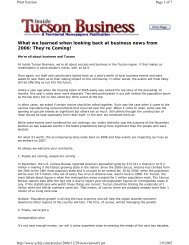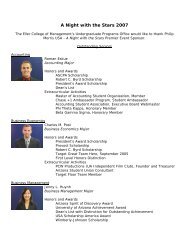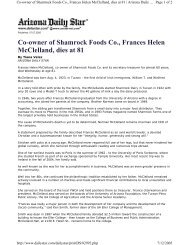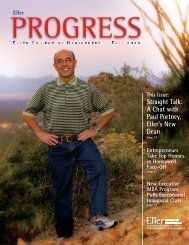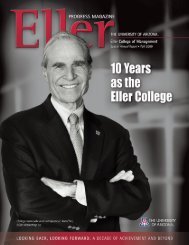PROGRESS MAGAZINE - Eller College of Management - University ...
PROGRESS MAGAZINE - Eller College of Management - University ...
PROGRESS MAGAZINE - Eller College of Management - University ...
Create successful ePaper yourself
Turn your PDF publications into a flip-book with our unique Google optimized e-Paper software.
BRIEFINGS<br />
RESEARCH REPORT<br />
Cash in Hand<br />
<strong>Eller</strong> pr<strong>of</strong>essors examine why U.S. firms are holding so much cash.<br />
Checks and Balances<br />
A new book examines American history through the economist’s eye.<br />
Hefty corporate cash holdings have generated significant media<br />
attention. In mid-2006, for example, Micros<strong>of</strong>t and Exxon-Mobile each<br />
had some $30 billion in cash holdings.<br />
<strong>Eller</strong> assistant pr<strong>of</strong>essor <strong>of</strong> finance Thomas W. Bates and associate<br />
pr<strong>of</strong>essor <strong>of</strong> finance and Susan Bulkeley Butler Faculty Fellow Kathleen<br />
Kahle examined the trend with René M. Stulz <strong>of</strong> The Ohio State<br />
<strong>University</strong>. The resulting paper, “Why do U.S. firms hold so much more<br />
cash than they used to?”, was featured in The New York Times in 2006.<br />
“This is the first paper to empirically document the change over<br />
time,” says Bates. He, Kahle, and Stulz analyzed data from 13,000 publicly<br />
traded U.S. firms from the period 1980 to 2004. They discovered<br />
that average cash holdings increased 129% over that period. What’s<br />
more, the change has been relatively steady over time with the average<br />
cash-to-assets ratio increasing by about 0.45% each year.<br />
“The trend bears out at firms across industries,” says Kahle. She says<br />
the effect is concentrated among firms that do not pay dividends, but<br />
is symptomatic in all U.S. firms. As a result, she explains, “given the<br />
increase in cash holdings, the average firm actually has negative net<br />
debt.” In other words, U.S. companies are holding enough cash to pay<br />
<strong>of</strong>f all their debts.<br />
One explanation, says Bates, is the increase in volatility over time.<br />
“Volatility is OK from a financial standpoint,” he says. “But some firms<br />
have risk that can’t be hedged — systematic or undiversifiable risk,<br />
such as productivity shocks or inflation.”<br />
“The increased cash holdings are precautionary in the sense that<br />
firms want that extra cushion <strong>of</strong> cash in bad times,” Kahle says. “Firms<br />
are also reducing inventory — moving toward a just-in-time approach<br />
— which frees up more cash.”<br />
Kathleen Kahle, Susan Bulkeley<br />
Butler Faculty Fellow.<br />
Thomas Bates, assistant<br />
pr<strong>of</strong>essor <strong>of</strong> finance.<br />
In addition, says Bates, the types <strong>of</strong> firms in the economy have evolved over time. “The focus has<br />
changed from hard assets to intangible research and development.” Given the lifespan <strong>of</strong> products —<br />
for example, in the pharmaceutical industry — companies can’t afford to stop or delay research and<br />
development if they want to stay competitive, and they need to be able to draw on cash resources to<br />
make it happen.<br />
Bates, Kahle, and Stulz are further refining the paper’s findings, which Bates says gave them a better<br />
feel for optimal cash models. “A more refined model will determine which companies are holding too<br />
much cash, and the next question is why. What are they doing with it? It signals a potential principal<br />
agent problem,” he explains, “particularly in firms where there is no one there to monitor the use<br />
<strong>of</strong> the cash.”<br />
The fundamentals <strong>of</strong> American history<br />
take on new dimension when viewed<br />
through the prism <strong>of</strong> economics. Sixteen<br />
leading U.S. economic historians have<br />
collaborated on a forthcoming book,<br />
Government and the American Economy<br />
— A New History, edited by Price Fishback,<br />
the <strong>Eller</strong> <strong>College</strong> Frank and Clara Kramer<br />
Pr<strong>of</strong>essor <strong>of</strong> Economics.<br />
“The idea was to write a book for the<br />
general public that highlights a large<br />
body <strong>of</strong> economic research that hasn’t yet<br />
made it into the popular history books,”<br />
says Fishback. Each <strong>of</strong> the book’s contributors<br />
is a recognized expert on a period in<br />
history, and the authors worked together<br />
to trace the evolution <strong>of</strong> government in<br />
the American economy from colonial<br />
times to the present.<br />
“People <strong>of</strong>ten think <strong>of</strong> the federal government<br />
as THE government,” Fishback<br />
says. “But state and local governments<br />
play considerable roles, as well.” The balance<br />
in power between these entities has<br />
cycled over time, he explains. “The<br />
Constitution gave the national government<br />
a restricted role, so that the states<br />
dominated economic policy making until<br />
the 1860s.” From 1865-1910, the majority<br />
<strong>of</strong> government investment in the economy<br />
occurred at the local level on projects<br />
such as schools, roads, and sanitation.<br />
The federal government responded to<br />
crises during the World Wars and the<br />
Great Depression by expanding its<br />
authority and spending dramatically. Even<br />
though the government gave up most<br />
<strong>of</strong> its command over the economy at<br />
the end <strong>of</strong> World War II, regulation<br />
and spending never returned to precrisis<br />
levels.<br />
The implications for the individual and<br />
for business are many. For example, an<br />
entrepreneur in the 1890s may have only<br />
had to meet local zoning and building<br />
code requirements. Today’s entrepreneurs<br />
must satisfy requirements set by a broad<br />
range <strong>of</strong> agencies at all levels, including<br />
the Occupational Safety and Health<br />
Administration and the Environmental<br />
Protection Agency at the national level.<br />
“Like it or not — and people disagree —<br />
that’s how things have changed,”<br />
Fishback says.<br />
The book also traces the origins <strong>of</strong> regulation<br />
in a wide range <strong>of</strong> industries.<br />
“Employers <strong>of</strong>ten played a major role in<br />
many labor reforms, like the minimum<br />
wage and child labor laws,” says Fishback.<br />
Typically, in order for the legislation to<br />
pass, a coalition <strong>of</strong> reformers had to<br />
partner with a group <strong>of</strong> employers.<br />
“Employers who were already following<br />
a practice could use the<br />
legislation as a club to damage<br />
competitors,” he explains.<br />
“In many ways, the history<br />
<strong>of</strong> government in the economy<br />
is a story <strong>of</strong> how interest<br />
groups interact with<br />
government, a fact<br />
anticipated by the<br />
founding fathers in the Federalist papers,”<br />
Fishback continues. In some situations, a<br />
single interest group obtains government<br />
policies that benefit it at the expense <strong>of</strong><br />
the rest <strong>of</strong> society. In many cases, however,<br />
major interest groups on both sides <strong>of</strong><br />
an issue counteract each other.<br />
“Overall,” says Fishback, “the U.S. economy<br />
has been among the most successful<br />
in the world because collectively our governments<br />
have done more than most to<br />
provide a stable administration <strong>of</strong> justice<br />
and to protect individual property rights<br />
and economic freedoms.”<br />
Government and the American Economy<br />
was published by the <strong>University</strong> <strong>of</strong><br />
Chicago press and is available on<br />
www.amazon.com.<br />
6 ELLER <strong>PROGRESS</strong> THE UNIVERSITY OF ARIZONA<br />
WWW.ELLER.ARIZONA.EDU<br />
SPRING 2007 7



